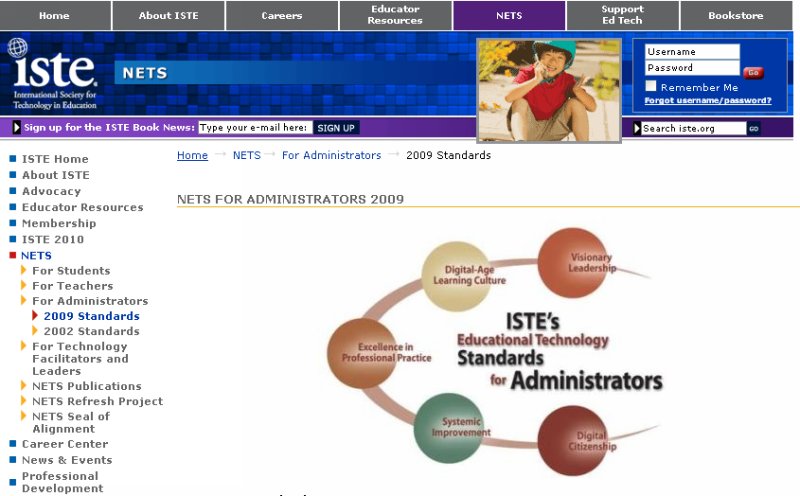NETS-A校長的教育科技指標2009~教育轉化
作者: 塾長 日期: 2009-11-09 21:47
一轉眼2009年只剩50天,趕緊把NETS-A2009校長的教育科技指標 做個介紹!Administrator,我們習慣以校長稱呼,不僅致力於校內的願景領導與文化型塑,也能在學區、地方到國家層級的教育轉型方面發揮影響力。
2002年版有六項:1.領導與願景、2.學習與教導、3.生產力與專業實務、4.支援、管理與操作、5.評量與評鑑、6.社會、法律與倫理議題。
2009年有五項: 1.願景領導、2.數位時代學習文化、3.卓越的專業實踐、4.系統化的改進、5.數位公民

1.具有願景的領導
教育管理者要能激勵和領導共同願景的發展與實踐~以全方位的科技整合,提昇整個組織的績效並支持轉型。
教育管理者能:
a.在所有的利害關係人之間,鼓舞和促成共同願景,這樣有目的的變革,是期望能最大化地利用數位時代各種資源,達成和超越學習目標,支持有效的教學實踐,也能最大化地提高學區和學校領導的績效。
b.在過程中持續參與,以發展、實施和溝通科技融入教學應用的策略規劃,並保持能與共同願景保持一致。
c.在地方,州和國家層級倡導相關政策,計劃和資金,期能支持科技融入的願景與策略規劃之執行。
1. Visionary Leadership
Educational Administrators inspire and lead development and implementation of a shared vision for comprehensive integration of technology to promote excellence and support transformation throughout the organization. Educational Administrators:
a. inspire and facilitate among all stakeholders a shared vision of purposeful change that maximizes use of digital-age resources to meet and exceed learning goals, support effective instructional practice, and maximize performance of district and school leaders.
b. engage in an ongoing process to develop, implement, and communicate technology-infused strategic plans aligned with a shared vision.
c. advocate on local, state and national levels for policies, programs, and funding to support implementation of a technology-infused vision and strategic plan.
2.數位時代的學習文化
教育管理者創造,促進和維持一個動態的、數位時代的學習文化,為所有學生提供一個徹底的,有價值的和引人投入的教育。
教育管理者能:
a.確保教學創新的重點,是聚焦於持續改進數位時代的學習。
b.示範與促進頻繁和有效利用科技於學習。
c.提供學習者為中心的環境,具備科技設備和學習資源,以滿足所有學習者個別、不同的需求。
d.針對科技及其融入課程的應用,要能持續實踐與研究以確保有效。
e.促進和參與地方,國家和全球學習社群,鼓勵創新,創造力和數位時代的合作。
2. Digital Age Learning Culture
Educational Administrators create, promote, and sustain a dynamic, digital-age learning culture that provides a rigorous, relevant, and engaging education for all students. Educational Administrators:
a. ensure instructional innovation focused on continuous improvement of digital-age learning.
b. model and promote the frequent and effective use of technology for learning.
c. provide learner-centered environments equipped with technology and learning resources to meet the individual, diverse needs of all learners.
d. ensure effective practice in the study of technology and its infusion across the curriculum.
e. promote and participate in local, national, and global learning communities that stimulate innovation, creativity, and digital-age collaboration.
3.卓越的專業實踐
教育管理者促進專業學習和創新的環境,授權教育人員藉由現代科技與資源的應用,提昇學生的學習。
教育管理員能:
a.分配時間,資源和管道,以確保持續的專業成長,要能將科技流暢與整合運用於教學。
b.促進和參與學習社群,以激勵,培育和支持行政人員,教師和工作夥伴能夠研究和使用科技。
c.能在利害關係人之間,利用數位時代工具促進和示範有效的溝通和合作。
d.掌握關於有效利用科技的教育研究與新趨勢,並鼓勵對於新科技能促進學生學習的潛力加以評估。
3. Excellence in Professional Practice
Educational Administrators promote an environment of professional learning and innovation that empowers educators to enhance student learning through the infusion of contemporary technologies and digital resources. Educational Administrators:
a.allocate time, resources, and access to ensure ongoing professional growth in technology fluency and integration.
b.facilitate and participate in learning communities that stimulate, nurture and support administrators, faculty, and staff in the study and use of technology.
c.promote and model effective communication and collaboration among stakeholders using digital-age tools.
d.stay abreast of educational research and emerging trends regarding effective use of technology and encourage evaluation of new technologies for their potential to improve student learning.
4.系統性的改進
教育管理者提供數位時代的領導和管理,透過有效地利用資訊和科技資源,持續改善組織。
教育管理者能:
a.引導有目的的改變,通過適當的科技應用和媒體豐富的資源,促使學習目標的成就最大化。
b.合作建立量規,蒐集並分析數據,解釋結果,並分享研究發現,以改進工作人員的績效和學生的學習。
c.招聘和留住高素質的人才,他們能有創意和熟練地善用科技,達成與提昇學術和經營目標。
d.建立和運用策略夥伴關係,以支持系統的改進。
e.建立和保持一個穩健的科技基礎建置,包括整合的,可相互合作的科技系統,以支持管理,運營,教學和學習。
4. Systemic Improvement
Educational Administrators provide digital-age leadership and management to continuously improve the organization through the effective use of information and technology resources. Educational Administrators:
a.lead purposeful change to maximize the achievement of learning goals through the appropriate use of technology and media-rich resources.
b.collaborate to establish metrics, collect and analyze data, interpret results, and share findings to improve staff performance and student learning.
c.recruit and retain highly competent personnel who use technology creatively and proficiently to advance academic and operational goals.
d.establish and leverage strategic partnerships to support systemic improvement.
e.establish and maintain a robust infrastructure for technology including integrated, interoperable technology systems to support management, operations, teaching, and learning.
5.數位公民
教育管理者示範並促進瞭解關於社會,倫理和法律問題和不斷發展的數位文化的相關責任。
教育管理者能:
a.確保適當的數位工具和資源的公平使用機會,以滿足所有學生的需要。
b.促進、示範與建立政策,期能安全、合法、合理地使用數位資訊和科技。
c.推廣和示範與科技和資訊使用相關的、負責任的社會互動。
d.示範和促進分享的文化理解之發展,並透過利用現代通信和合作工具,參與全球性議題。
5. Digital Citizenship
Educational Administrators model and facilitate understanding of social, ethical and legal issues and responsibilities related to an evolving digital culture. Educational Administrators:
a.ensure equitable access to appropriate digital tools and resources to meet the needs of all learners.
b.promote, model and establish policies for safe, legal, and ethical use of digital information and technology.
c.promote and model responsible social interactions related to the use of technology and information.
d.model and facilitate the development of a shared cultural understanding and involvement in global issues through the use of contemporary communication and collaboration tools.
 訂閱
訂閱 上一篇
上一篇 返回
返回 下一篇
下一篇

 標籤:
標籤:


18年數位原生能力轉變與期待 (2016-07-02 17:18)
NETS-T老師的教育科技指標2008~支持數位時代的學習者 (2008-07-20 16:16)
NETS-S學生的教育科技指標2007~數位時代的全球學習 (2008-07-20 15:43)